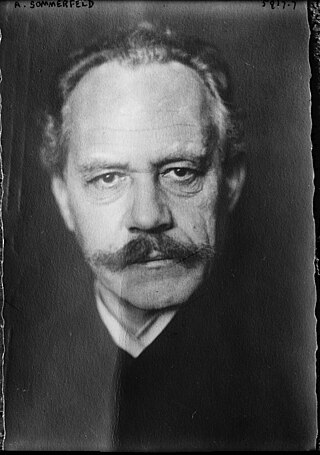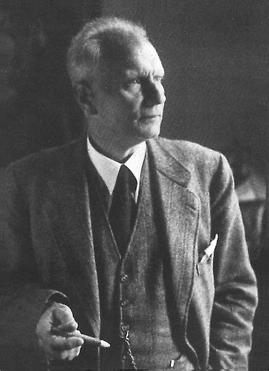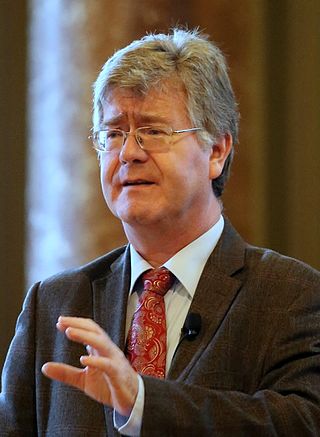
Arnold Johannes Wilhelm Sommerfeld, was a German theoretical physicist who pioneered developments in atomic and quantum physics, and also educated and mentored many students for the new era of theoretical physics. He served as doctoral supervisor and postdoc supervisor to seven Nobel Prize winners and supervised at least 30 other famous physicists and chemists. Only J. J. Thomson's record of mentorship offers a comparable list of high-achieving students.

Friedrich Hermann Hund was a German physicist from Karlsruhe known for his work on atoms and molecules. He is known for the Hund's rules to predict the electron configuration of chemical elements. His work on Hund's cases and molecular orbital theory allowed to understand the structure of molecules.

Walther Wilhelm Georg Bothe was a German nuclear physicist known for the development of coincidence methods to study particle physics.

Max Theodor Felix von Laue was a German physicist who received the Nobel Prize in Physics in 1914 for his discovery of the diffraction of X-rays by crystals.

The Kaiser Wilhelm Society for the Advancement of Science was a German scientific institution established in the German Empire in 1911. Its functions were taken over by the Max Planck Society. The Kaiser Wilhelm Society was an umbrella organisation for many institutes, testing stations, and research units created under its authority.

Walther Gerlach was a German physicist who co-discovered, through laboratory experiment, spin quantization in a magnetic field, the Stern–Gerlach effect. The experiment was conceived by Otto Stern in 1921 and successfully conducted first by Gerlach in early 1922.

The Order of Karl Marx was the most important order in the German Democratic Republic (GDR). The award of the order also included a prize of 20,000 East German marks.

The German Physical Society is the oldest organisation of physicists. As of 2022, the DPG's worldwide membership is cited as 52,220, making it one of the largest national physics societies in the world. The DPG's membership peaked in 2014 when it reached 63,000, but it has been decreasing since then. It holds an annual conference and multiple spring conferences, which are held at various locations and along topical subjects of given sections of the DPG. The DPG serves the fields of pure and applied physics and aims to foster connections among German physicists, as well as the exchange of ideas between its members and foreign colleagues. The bylaws of the DPG commit the organization and its members to maintain scientific integrity and ethics, including freedom, tolerance, truthfulness, and dignity in scientific work, as well as promoting gender equality in the fields of physics and related sciences.

The Max Born Medal and Prize is a scientific prize awarded yearly by the German Physical Society (DPG) and the British Institute of Physics (IOP) in memory of the German physicist Max Born, who was a German-Jewish physicist, instrumental in the development of quantum mechanics. It was established in 1972, and first awarded in 1973.

The Liebig Medal was established by the Association of German Chemists in 1903 to celebrate the centenary of Justus von Liebig. Since 1946 it has been awarded by the Society of German Chemists.
The Stern–Gerlach Medal is the most prestigious prize for experimental physicists awarded by the German Physical Society. It is named after the scientists of the Stern–Gerlach experiment, Otto Stern and Walther Gerlach. It was originally called the Stern–Gerlach Prize, and has been awarded annually since 1988. It was converted into a medal in 1992.
Wolfgang Gentner was a German experimental nuclear physicist.
The highest award which is presented by the Max Planck Society for services to society is the Harnack Medal, first awarded in 1925. The Harnack Medal is named after the theologian Adolf von Harnack, who was the first president of the Kaiser Wilhelm Society, the predecessor organization of the MPG, from 1911 to 1930. The medal has only been awarded 33 times since 1924, including 10 times by the Kaiser Wilhelm Society (1924–1936) and 23 times by the Max Planck Society (1953–2017).
The Karl-Scheel-Preis is an award given annually by the Physikalische Gesellschaft zu Berlin, a regional association of the Deutsche Physikalische Gesellschaft, for outstanding scientific work. The prize was established through an endowment by the German physicist Karl Scheel and his wife Melida. Recipients are awarded with the Karl-Scheel Medal and 5.000 Euros. The Karl-Scheel Medal in bronze was designed by the German sculptor Richard Scheibe and has a diameter of 12 cm.

Wolfgang P. Schleich is professor of theoretical physics and director of the quantum physics department at the University of Ulm.

The Otto Hahn Prize is awarded biennially jointly by the Society of German Chemists, the German Physical Society and the city of Frankfurt am Main for outstanding achievement in the field of chemistry, physics or applied engineering science. It was established in 2005 by the merger of the previous Otto Hahn Prize for Chemistry and Physics and the Otto Hahn Prize of the City of Frankfurt am Main. The award is presented in the St. Paul's Church, Frankfurt am Main.

Cothenius Medal is a medal awarded by the German National Academy of Sciences Leopoldina for outstanding scientific achievement during the life of the awardee. The medal was created to honour Christian Andreas Cothenius, who was the personal physician to Frederick the Great. In 1743, Cothenius became a fellow of the Leopoldina, later president of the learned society that had been created by Emperor Leopold I. When Cothenius died, he left a sum of money in his will to the society with the condition that the interest on the money should be used to award a gold medal, every two years by answering a question in medicine whereby some new truth could be established. Up until 1864, the award came with a prize but was then converted into an award for the promotion of research over the whole period of a person's life. Each medal bears the Latin inscription "Praemium virtutis salutem mortalium provehentibus sancitum".













